Quarters
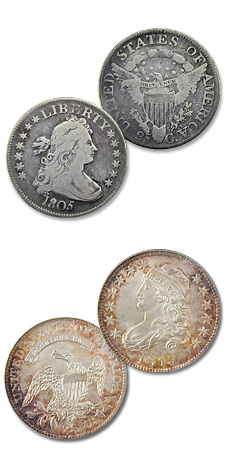
The Draped Bust (above) and Capped Bust quarters, featuring Liberty on the obverse, were minted only in Philadelphia.
Draped Bust Quarters, 1796‑1807
When America's first quarters were issued, George Washington was president and the government seat was in New York City. Authorized with the original Mint Act of 1792, quarters weren't released until 1796. The first quarter design to debut was the Draped Bust series of 1796-1807. It featured a stunning portrait of Liberty with flowing hair on the obverse, while the reverse showed an eagle within a wreath. In 1804, the small eagle on the reverse gave way to the Heraldic Eagle design, which lasted until the series' end. The denomination was also added to the reverse as 25 C. for the first time.
Capped Bust Quarters, 1815‑1838
Quarters were suspended after 1807. They were not issued again until 1815, when the Capped Bust design was introduced. Though similar in styling to the earlier Draped Bust coinage, Liberty now sported a cap on her head tied with a ribbon inscribed LIBERTY. And while the eagle was still displayed on the reverse, it too had been modified. Capped Bust quarters were issued until 1828. Following yet another suspension of America's quarters in 1829 and 1830, the Capped Bust design was issued once again from 1831-1838. The most noticeable difference in the later-issue Capped Bust quarters was the diameter – which was reduced from 27 to 24.3 mm.
See our Capped Bust Quarter inventory
Liberty Seated Quarters, 1838-1891

Liberty Seated silver quarters were issued for over 50 years, through the Civil War era and the nation's expansion into western territories.
In 1838, the quarter design was replaced once again – this time by Christian Gobrecht's Liberty Seated design, which also appeared on the dime, half dollar and dollar during a similar time frame. This new design featured Liberty seated on a rock. In her left hand she held a pole with a liberty cap perched on its end. Her right hand propped a shield with the inscription LIBERTY. This design continued through America's Civil War, and though the design was modified on four occasions, the Liberty Seated quarter continued until 1891.
See our Liberty Seated Quarter inventory
Barber Quarters, 1892‑1916
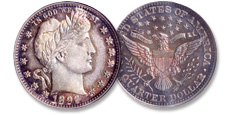
Named for their designer, classic 1892-1916 Barber silver quarters witnessed America's modernization during the turn of the 20th century.
America's silver coinage designs changed once again in 1892, when the quarter – along with the dime and half dollar – all adopted Charles Barber's Liberty Head motif. Liberty's head, donning a Phrygian cap with a laurel wreath, is the obverse's main design element. The Barber quarter continued into the 20th century, replaced in 1916 by the final early American quarter design – the controversial Standing Liberty coin.
See our Barber Quarter inventory
Standing Liberty Quarters, 1916‑1930
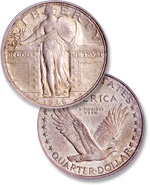
This later Standing Liberty quarter design replaced the earlier controversial depiction of Liberty.
Though well received, the Standing Liberty design caused a stir before the end of its first year. The original Type I design featured Liberty standing in a gateway with a branch in her right hand and a shield in her left. What some took offense to was her gown – which draped, exposing her right breast. Due to some well-publicized complaints, the design was modified partway through its second year. The more modest Type II coins bore the same image of Liberty in a gateway – with her chest covered entirely by chain mail.
The Standing Liberty quarter was discontinued in 1930, paving the way for the long-running Washington quarter – and the era of modern quarter designs.
See our Standing Liberty Quarter inventory
Washington Quarters, 1932‑Date
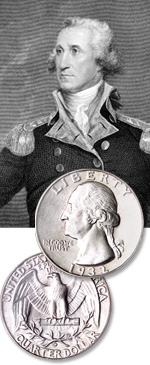
The Washington quarter, issued since 1932, was intended to be a one-year-only commemorative.
The Washington quarter is one of the longest running obverse designs of US coinage. First issued in 1932, the coin was intended to be a one-year-only commemorative celebrating the 200th anniversary of George Washington's birth. But in 1934, US lawmakers voted to continue producing it. Created by renowned sculptor John Flanagan, whose composition was chosen over 97 other designs in an open competition, the Washington quarter was the second regular-issue US coin to picture a famous American.
The designer's initials, "JF," were placed at the base of George Washington's neck on the obverse of all the Washington quarters. The coins struck at the main US Mint in Philadelphia were not given mint marks, while those produced at the Denver and San Francisco Mints received "D" and "S" mint marks, respectively, placed below the wreath on the reverse.
As with dimes and half dollars, US quarters were struck in 90% fine silver until 1964, when rising silver prices forced a change in composition. By the late 1970s and early 80s, silver prices spiked to over $50 per ounce in reaction to an attempt to corner the world's silver supply. During this period, huge quantities of US silver coins were melted down. As a result, the number of each pre-1965 silver Washington quarter in existence is unknown (thus, the amount may be smaller than indicated).
See our classic Washington Quarter inventory
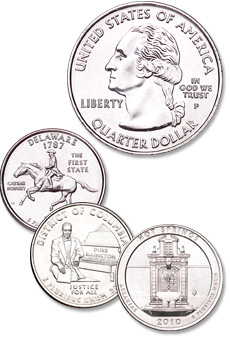
The original Washington obverse design was modified slightly to accommodate wording previously shown on the reverse. Each unique reverse design is minted only for about ten weeks.
1999-2009 Statehood, D.C. & US Territories Quarters
From 1999-2008, the 50 states were honored with 5 special quarter designs per year in the order of statehood. In 2009, the District of Columbia was honored, followed by the 5 US territories in the order of territorial establishment. Learn more about the Statehood Quarter designs, or how to start a Statehood Quarter collection.
See our Statehood and D.C. & US Territories Quarter inventory
2010-2021 America's National Park Quarter Series
Launched in 2010, a new commemorative quarter program features a national park or historic site in all 50 states, D.C. and the 5 US territories – with 5 new locations honored each year in the order of establishment as federally protected sites. Read more about the National Park Quarters or how to start a National Park Quarter collection.
See our National Park Quarter inventory

